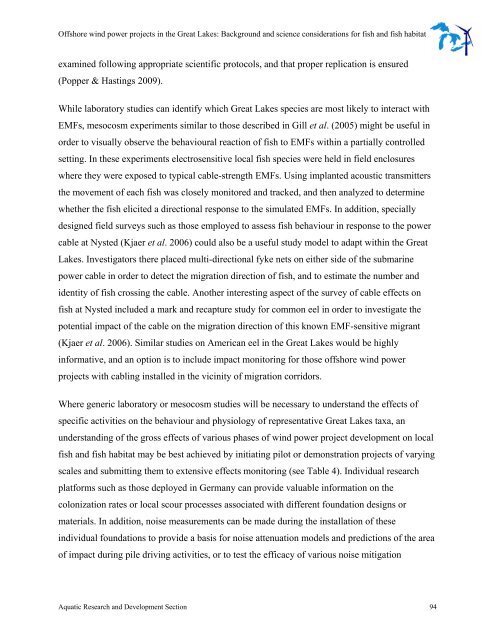Offshore Wind Power Projects in the Great Lakes - Ministry of ...
Offshore Wind Power Projects in the Great Lakes - Ministry of ...
Offshore Wind Power Projects in the Great Lakes - Ministry of ...
Create successful ePaper yourself
Turn your PDF publications into a flip-book with our unique Google optimized e-Paper software.
<strong>Offshore</strong> w<strong>in</strong>d power projects <strong>in</strong> <strong>the</strong> <strong>Great</strong> <strong>Lakes</strong>: Background and science considerations for fish and fish habitat<br />
exam<strong>in</strong>ed follow<strong>in</strong>g appropriate scientific protocols, and that proper replication is ensured<br />
(Popper & Hast<strong>in</strong>gs 2009).<br />
While laboratory studies can identify which <strong>Great</strong> <strong>Lakes</strong> species are most likely to <strong>in</strong>teract with<br />
EMFs, mesocosm experiments similar to those described <strong>in</strong> Gill et al. (2005) might be useful <strong>in</strong><br />
order to visually observe <strong>the</strong> behavioural reaction <strong>of</strong> fish to EMFs with<strong>in</strong> a partially controlled<br />
sett<strong>in</strong>g. In <strong>the</strong>se experiments electrosensitive local fish species were held <strong>in</strong> field enclosures<br />
where <strong>the</strong>y were exposed to typical cable-strength EMFs. Us<strong>in</strong>g implanted acoustic transmitters<br />
<strong>the</strong> movement <strong>of</strong> each fish was closely monitored and tracked, and <strong>the</strong>n analyzed to determ<strong>in</strong>e<br />
whe<strong>the</strong>r <strong>the</strong> fish elicited a directional response to <strong>the</strong> simulated EMFs. In addition, specially<br />
designed field surveys such as those employed to assess fish behaviour <strong>in</strong> response to <strong>the</strong> power<br />
cable at Nysted (Kjaer et al. 2006) could also be a useful study model to adapt with<strong>in</strong> <strong>the</strong> <strong>Great</strong><br />
<strong>Lakes</strong>. Investigators <strong>the</strong>re placed multi-directional fyke nets on ei<strong>the</strong>r side <strong>of</strong> <strong>the</strong> submar<strong>in</strong>e<br />
power cable <strong>in</strong> order to detect <strong>the</strong> migration direction <strong>of</strong> fish, and to estimate <strong>the</strong> number and<br />
identity <strong>of</strong> fish cross<strong>in</strong>g <strong>the</strong> cable. Ano<strong>the</strong>r <strong>in</strong>terest<strong>in</strong>g aspect <strong>of</strong> <strong>the</strong> survey <strong>of</strong> cable effects on<br />
fish at Nysted <strong>in</strong>cluded a mark and recapture study for common eel <strong>in</strong> order to <strong>in</strong>vestigate <strong>the</strong><br />
potential impact <strong>of</strong> <strong>the</strong> cable on <strong>the</strong> migration direction <strong>of</strong> this known EMF-sensitive migrant<br />
(Kjaer et al. 2006). Similar studies on American eel <strong>in</strong> <strong>the</strong> <strong>Great</strong> <strong>Lakes</strong> would be highly<br />
<strong>in</strong>formative, and an option is to <strong>in</strong>clude impact monitor<strong>in</strong>g for those <strong>of</strong>fshore w<strong>in</strong>d power<br />
projects with cabl<strong>in</strong>g <strong>in</strong>stalled <strong>in</strong> <strong>the</strong> vic<strong>in</strong>ity <strong>of</strong> migration corridors.<br />
Where generic laboratory or mesocosm studies will be necessary to understand <strong>the</strong> effects <strong>of</strong><br />
specific activities on <strong>the</strong> behaviour and physiology <strong>of</strong> representative <strong>Great</strong> <strong>Lakes</strong> taxa, an<br />
understand<strong>in</strong>g <strong>of</strong> <strong>the</strong> gross effects <strong>of</strong> various phases <strong>of</strong> w<strong>in</strong>d power project development on local<br />
fish and fish habitat may be best achieved by <strong>in</strong>itiat<strong>in</strong>g pilot or demonstration projects <strong>of</strong> vary<strong>in</strong>g<br />
scales and submitt<strong>in</strong>g <strong>the</strong>m to extensive effects monitor<strong>in</strong>g (see Table 4). Individual research<br />
platforms such as those deployed <strong>in</strong> Germany can provide valuable <strong>in</strong>formation on <strong>the</strong><br />
colonization rates or local scour processes associated with different foundation designs or<br />
materials. In addition, noise measurements can be made dur<strong>in</strong>g <strong>the</strong> <strong>in</strong>stallation <strong>of</strong> <strong>the</strong>se<br />
<strong>in</strong>dividual foundations to provide a basis for noise attenuation models and predictions <strong>of</strong> <strong>the</strong> area<br />
<strong>of</strong> impact dur<strong>in</strong>g pile driv<strong>in</strong>g activities, or to test <strong>the</strong> efficacy <strong>of</strong> various noise mitigation<br />
Aquatic Research and Development Section 94
















